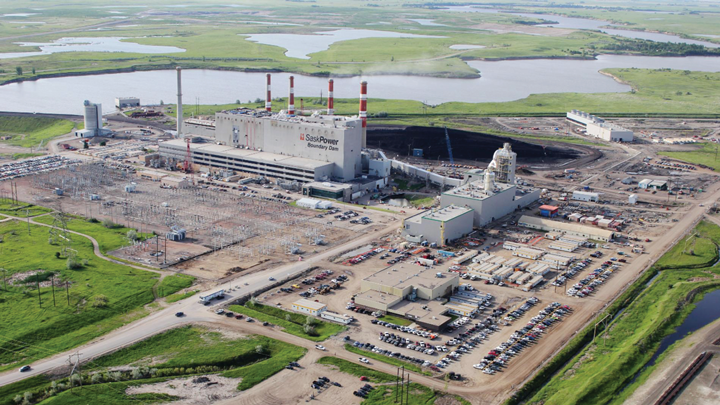The Privilege of Being First
An insider’s view of the technical challenges overcome at the pioneering Boundary Dam CCS project. David Jobe, Director of Carbon Capture and Chemical Services at Saskpower speaks to Adam Duckett
AT first glance, Canada’s Boundary Dam power plant looks much like any other. Drive through the flat prairieland south of the city of Estevan, and you will see its grey bulk and towering smokestacks punctuating the horizon from miles around. It is a coal-fired power plant, one of more than 2,000 operating around the world.
But in this case, first impressions deceive. Boundary Dam can rightly claim to be a pioneer. In October 2014, it became the world’s first coal-fired power plant to implement a full-scale, fully-integrated, post-combustion CCS system. Using an amine capture process licensed from Shell, it set out to capture 90% of CO2 emissions from the coal burned in the plant’s third unit, producing 1m t/y of CO2.
With the ribbon cut, and the fanfare fading, problems soon set in. In 2015, it became apparent that the plant had serious design issues.
One year after operations began, the plant was operating at just 40% capacity, a problem made all the more serious by the fact it was being penalised financially for failing to supply enough of the CO2 it had committed to sell to a local oil producer for enhanced oil recovery (EOR).
“Let’s just say that out of the box, the plant didn’t work as designed,” says SaskPower’s David Jobe.
Jobe, a chemist and licensed engineer, explains that as one of the senior chemical people in the corporation, he got “tapped on the shoulder to come down and help.”

Capture plant
Fast-forward three years and the C$1.4bn (US$1.1bn) project is now in a much healthier position, with targets this year to capture 800,000 t of CO2. It is short of the original target, but given the challenges faced, it is a considerable achievement.
Jobe, who is now SaskPower’s director of carbon capture and chemical services, starts by describing the process.
“The carbon capture part starts after the coal is burned. At the backend of the power plant there’s a damper that allows us either to divert the flue gas up the stack in the traditional fashion or bring the flue gas over to the capture plant.”
After it is piped to the adjacent capture plant, the emissions are put through a flue gas cooler to bring the temperature down from 199oC to around 89oC, which helps enhance adsorption of the CO2 and SO2. SaskPower enhanced this process by adding a polymer heat exchanger which pre-heats the condenser water used for steam generation in the power plant.
The cooler also condenses out the moisture that comes from the lignite – a poor quality coal – burned at the plant. This moisture is not wasted, it is diverted to the cooling tower.
“The flue gas then passes into what we call the ‘100 Tower’ where the SO2 gas is removed.”
In the tower, the gas first passes through a pre-scrubber that further cools the gas and removes contaminants; then bubbles up through the scrubber where liquid amines absorb the SO2; and on to the caustic polisher section that reuses residual caustic generated in the CO2 capture system to remove the remaining SO2.
“And then the flue gas is passed over to the second absorption tower which is the carbon dioxide capture system. It works virtually the same way as the SO2 capture system: you have an amine recirculating in part of the tower and that removes the CO2 and then the flue gas is allowed to go up to the top of the stack.”
What is released is 99.99% water he explains, with only trace amounts of CO2 and degradation products formed from the reactions that occur with the amines.
“So, the amines capture the gas in the absorption towers and then we pop it down to the stripping process where it is heated back up again – and that releases both the SO2 and the CO2 from the respective amine systems.”

While the regenerated amine is returned to the scrubber to capture more gas, the SO2 moves to an acid plant where it is catalytically converted to SO3 and water added to produce around 18-20 t/d of sulfuric acid. This is sold to local industry, principally for fertiliser production.
The captured CO2 comes out of the stripper at 16 psi and is passed through an eight-stage compressor to ramp it up to around 2,500 psi, producing supercritical CO2.
The purity of the CO2 cannot be disclosed due to contractual arrangements with the buyer, with SaskPower noting only that it is high purity.
“Our production rate is now sitting at around 2,600 t/d of supercritical CO2 and then we pump that around 80 km to an old oil field [for use in enhanced oil recovery],” Jobe says.
“In a nutshell, that’s the process.”
Recent Editions
Catch up on the latest news, views and jobs from The Chemical Engineer. Below are the four latest issues. View a wider selection of the archive from within the Magazine section of this site.




